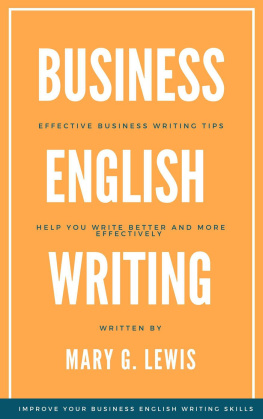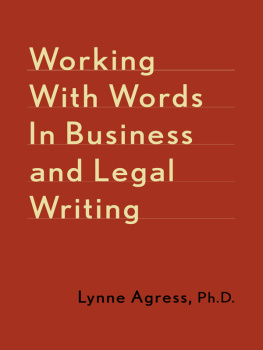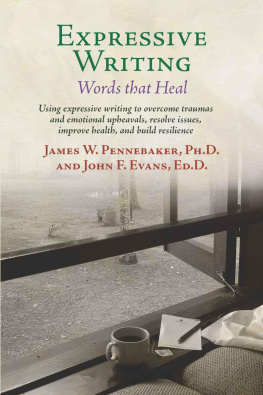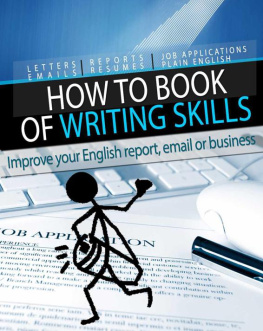Fundamentals of Business Writing
Fundamentals of Business Writing
Joseph C. Mancuso
Yvonne V. Chabrier

I dedicate Fundamentals of Business Writing to
Paul Charles Mancuso
Harvard, A.B.
State University of New York at Buffalo, M.L.S
my brother and colleague
1992 American Management Association. All rights reserved. This material may not be reproduced, stored in a retrieval system, or transmitted in whole or in part, in any form or by any means, electronic, mechanical, photocopying, recording, or otherwise, without the prior written permission of the publisher.
Printed in the United States of America.
Contents
About This Course
As one course among many offered in our curriculum, Fundamentals of Business Writing has been designed specifically for the practicing manager and the future manager. It provides private, self-paced, individualized study; learning and self-evaluation through in-text exercises; and communication between the student and our staff of instructors through a pre-test and a post-test. Paralleling a business school course study, our curriculum makes available a stable, inclusive, and continuing transmittal of practices and perspectives to those working managers who, on their own time and at their own pace, want to continue their education.
Joseph C. Mancuso, Ph.D., develops and teaches technical communication courses at Texas Instruments in Dallas. He has written two textbooks, Mastering Technical Writing (Addison Wesley, 1990) and Technical Editing (Prentice Hall, 1992), and more than a dozen articles for The Technical Writing Teacher, Technical Communication, Journal of Technical Writing and Communication, and other journals. He has served as a faculty member at the University of North Carolina, Chapel Hill, and at the University of North Texas, where he developed and directed the Technical Writing Program.
Yvonne V. Chabrier, a consultant on business communications, teaches seminars and writes training materials on business presentations for several corporations, including AT&T, Digital Equipment Corporation, Ford Motor Company, Bank of Boston, and GTE Laboratories. She was a reporter for LIFE magazine, and is also a feature writer for The Washington Post, Boston Magazine, and other periodicals.
The publisher wishes to thank B. E. Morefield, Quality Consultant, NCR Corporation of Dayton, Ohio, and John Vittal, GTE Laboratories of Waltham, Massachusetts, for their help in reviewing the manuscript of this course.
How to Take This Course
This course consists of text material for you to read and three types of activities (the pre- and post-test, in-text exercises, and end-of-chapter review questions) for you to complete. These activities are designed to reinforce the concepts introduced in the text portion of the course and to enable you to evaluate your progress.
PRE- AND POST-TESTS
Both a pre-test and post-test are included in this course. Take the pre-test before you study any of the course material to determine your existing knowledge of the subject matter. Submit one of the scannable answer forms enclosed with this course for grading. On return of the graded pre-test, complete the course material. Take the post-test after you have completed all the course material. By comparing results of the pre-test and the post-test, you can measure how effective the course has been for you.
To have your pre-test and post-test graded, please mail your answer forms to:
Educational Services
American Management Association
P.O. Box 133
Florida, NY 10921
All tests are reviewed thoroughly by our instructors and will be returned to you promptly.
THE TEXT
The most important component of this course is the text, where the concepts and methods are presented. Reading each chapter twice will increase the likelihood of your understanding the text fully.
We recommend that you work on this course in a systematic way. Reading the text and working through the exercises at a regular and steady pace will help ensure that you get the most out of this course and retain what you have learned.
In your first reading, concentrate on getting an overview of the chapter content. Read the learning objectives at the beginning of the chapter first. They will act as guidelines to the major topics of the chapter and identify the skills you should master as you study the text. As you read the chapter, pay attention to the headings and subheadings. Find the general theme of each section and see how that theme relates to others. Dont let yourself get bogged down with details during the first reading; simply concentrate on understanding and remembering the major themes.
In your second reading, look for the details that underlie the themes. Read the entire chapter carefully and methodically, underlining key points, working out the details of examples, and making marginal notes as you go. Complete the activities.
ACTIVITIES
Interspersed with the text of each chapter you will find a series of activities. These can take a variety of forms, including essays, short-answer quizzes, or charts and questionnaires. Completing the activities will enable you to try out new ideas, practice and improve new skills, and test your understanding of the course content.
THE REVIEW QUESTIONS
After reading a chapter and before going on to the next chapter, work through the Review Questions. Answering the questions and comparing your answers to those given will help you to grasp the major ideas of that chapter. If you perform these self-check exercises consistently, you will develop a framework in which to place material presented in later chapters.
GRADING POLICY
The American Management Association will continue to grade examinations and tests for one year after the courses out-of-print date.
If you have questions regarding the tests, the grading, or the course itself, call Educational Services at 1-800-225-3215 or send an e-mail to ed_svc@amanet.org.
.
Pre-Test
Fundamentals of Business Writing 9567A
Name
____________________________
Address
____________________________
____________________________
____________________________
Social Security No.
____________________________
Association/company through which you ordered this course
____________________________
Telephone No. Date test taken
Please type or print clearly
INSTRUCTIONS: Answer questions directly on these sheets. To answer the questions, circle the letter of the correct answer or fill in the blank. Be sure to keep a copy of your completed test for your records. No photocopies will be graded . When completed, mail your test to:
American Management Association
Educational Services
P.O. Box 133
Florida, NY 10921
Name four steps in an effective business writing process.
(a) Analyze, organize, write, revise
(b) Write, revise, write, revise
(c) Organize, write the first draft, revise, write the final draft
(d) Organize, write, edit, revise
An effective business style relies on which of the following strategies?
Next page








